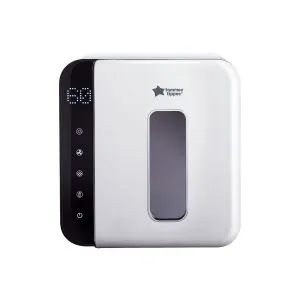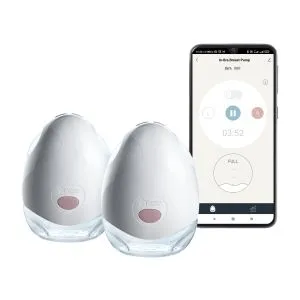
Tommee Tipps
Let’s run through why you may be experiencing nipple pain when breastfeeding, cover some top tips for sore nipple relief, and answer some of the most common questions moms ask about nipple soreness.
Treating Sore Nipples from Breastfeeding
Lots of people experience some level of nipple tenderness when they first start breastfeeding, usually when their baby first latches. But this initial discomfort should ease up the more you breastfeed and get into a feeding position that’s comfortable for you and your baby.
For some, sore nipples can be an ongoing issue. As many as 90% of new moms experience them at some point. Thankfully, though, there're plenty of ways to alleviate nipple pain, tenderness, or soreness.
Let’s run through why you may be experiencing nipple pain when breastfeeding, cover some top tips for sore nipple relief, and answer some of the most common questions moms ask about nipple soreness.
Why am I experiencing breastfeeding nipple pain?
One of the most common causes of sore nipples when breastfeeding is that the baby’s latch or positioning isn't correct. This can be because:
- Baby is slipping when feeding
- Baby has a tongue tie, which restricts their ability to feed
- Mom has flat or inverted nipples, which can make it difficult for their baby to latch on
- Mom has swollen breasts (edema) or breast engorgement, which can also cause issues with their baby's latch
- Baby is feeding late or parents missing their feeding cues. This can also lead to an improper or incomplete latch.
Other causes of breast and nipple pain while breastfeeding
- Nipple trauma: Wearing clothes that are too tight or not releasing baby's latch properly when they're done breastfeeding can cause nipple trauma. To release their latch, gently slide a clean finger into their mouth to break the hold they have on your nipple. Incorrect use of a breast pump – such as setting the suction too high or using a horn that doesn’t fit properly – can also cause nipple trauma.
- Nipple blanching: Also known as vasospasm, nipple blanching is the sudden narrowing of blood vessels in the nipple. This can be triggered by breastfeeding and can lead to nipple and deeper breast pain.
- Fungal infection: Infections like thrush can cause nipples to itch, burn, crack, or appear pink and flaky. If you have thrush, you may experience shooting pains between feeds. It can also sometimes be passed onto baby as they feed, presenting as white spots on their tongue, cheeks, and gums.
- Eczema: Severe dry skin or eczema can cause nipples to crack or bleed. Some moms experience eczema for the first time when they're pregnant.
- Milk blisters or blebs: These are smooth, shiny white dots on the nipple that are caused by clogged pores. They happen when a piece of skin or hardened breast milk gets blocked in the pore.
- Blocked milk ducts: Milk ducts can sometimes become clogged. This can lead to pain in the area and a hard lump forming under the skin.
- Mastitis: Mastitis occurs in one-third of postpartum women. Caused by inflammation of the breast, it can lead to sore breasts that have red streaks or become uncomfortably hard in one area. Some people experience a fever and chills, too.
Top tips for sore nipple relief
If you can, it's important to carry on breastfeeding even if your nipples feel sore. If you feel discomfort during nursing, you should stop and reposition the baby to encourage a better latch.
Waiting longer between feeds can result in your baby having a more aggressive suck due to their hunger. This can also lead to breast engorgement, which can make it difficult for them to latch on. All this can contribute to sore nipples. Additionally, feeding or pumping less can impact your milk supply.
If feeding is too painful, you can use a breast pump or hand express instead. Expressing your breast milk manually or using a breast pump and then feeding your baby with a bottle can help by giving your nipples a break and time to heal.
Even in the case of a breast infection like mastitis, it’s best to continue breastfeeding if you can, unless you've been advised otherwise by a health professional. The antibodies in your milk help to protect your baby from infections.
Finding the right type of relief for your sore nipples depends on what's triggering the discomfort in the first place.
Here are some ways to alleviate nipple soreness and discomfort caused by breastfeeding:
- Ensuring your baby is properly latched onwhen feeding. Once your baby's latch is improved, your sore nipples should heal on their own. Georgia says that "the first latch was painful, I remember having nightmares about the baby not being able to latch. It was traumatic, I remember rocking back and forth thinking I can't do this. But wanting to breastfeed so badly, I carried on. Luckily, the team sent specialist breastfeeding support round and it turned out the latch was incorrect. It was ok after that, but I can imagine people think the pain is normal".
- Making sure you break the suction of their latch before removing your baby from the breast.
- Trying different breastfeeding positionsto see if they work better and are more comfortable for you and your baby.
- Changing your breast padsafter each feed.
- Wearing soft, cotton nursing bras that fit correctly.
- Avoiding irritants in soap or detergents. Instead, use ordinary mild soap – not antibacterial.
- Dabbing expressed breastmilk onto your nipples after feeds.
- Applying a warm water compress to soothe your nipples.
- Applying a cold compress or chilled cabbage leaves can soothe sore breasts.
- Using silicone nipple shields when breastfeeding to protect your nipples. Looking back at her breastfeeding journey, Sarah says that "at one point, [she] was in so much pain that [she] considered stopping, until the midwife gave [her] a nipple shield to allow [her] nipple to heal whilst continuing breastfeeding. It really helped [her] and saved [her] from stopping altogether".
- Applyingnipple cream to soothe sore nipples.
- Taking breastfeeding-friendly painkillers or anti-inflammatory medication. Ibuprofen and acetaminophen are compatible with breastfeeding. But if you're not sure about a painkiller, consult a pharmacist for reassurance.
Preventing sore nipples from breastfeeding
Parents understandably want to do all they can to stop their nipples from becoming sore while they breastfeed. The main two things to bear in mind are making sure you have a good latch and a comfortable and effective breastfeeding position.
Not spotting your baby's early hunger cues can result in an improper latch, which can result in nipple pain. Look out for the following signs so that you can feed your baby before they become too hungry and latch on incorrectly:
- Baby is restless
- They are sucking on their fingers or fist
- They make murmuring noises
- Their head keeps turning and they’re opening their mouth
- They keep flexing their arms and legs
- Baby starts crying– this is a late hunger cue.
Some breastfeeding positions can help to reduce the risk of nipple pain, including laid-back, cradle, cross cradle, and football holds.
What can I do if my sore nipples don’t get better?
If you're experiencing pain when feeding or sore nipples that are not healing, you should ask for help and advice from your health visitor, doctor, or the USLCA - United States Lactation Consultant Association.
Breastfeeding nipple pain FAQs
How long will my nipples be sore from breastfeeding?
Some people will feel a few moments of discomfort at the beginning of a nursing session but this usually eases over time. However, if your nipple pain persists for more than seven days, or goes away and then returns, you should reach out to your healthcare provider or a lactation consultant for advice.
What is the fastest way to heal sore nipples?
Some moms find that applying warm, moist heat – such as through a clean washcloth – to the area can help. Hand expressing a small amount of breast milk and gently rubbing or patting it onto the affected area can help soothe any discomfort.
Can I pump to relieve sore nipples?
If you can, it's best to continue to breastfeed when you’re experiencing nipple soreness or pain. But you can switch to pumping and then offering breast milk in a bottle for a few days to give yourself a break if breastfeeding directly is too uncomfortable.
However, frequent pumping can sometimes make nipples sore, so consult a lactation consultant for proper pumping guidance and to help avoid further nipple damage.
Sources
- Nipple Pain Remedies - American Pregnancy Association
- Nipple Vasospasm and Breastfeeding - Breastfeeding Support
- Breastfeeding FAQs: Pain and Discomfort (for Parents) - Nemours KidsHealth
- Milk Bleb: Blister, Causes, Symptoms & Treatment (clevelandclinic.org)
- Help for Sore Nipples | WIC Breastfeeding Support (usda.gov)
- Nipple fissure: Cracked or bleeding nipples when breastfeeding | BabyCenter
- How to Prevent Sore Nipples When Breastfeeding (verywellfamily.com)











